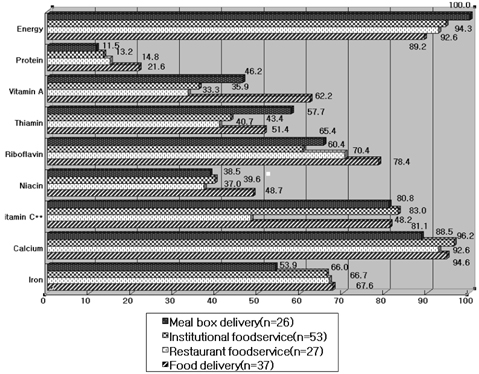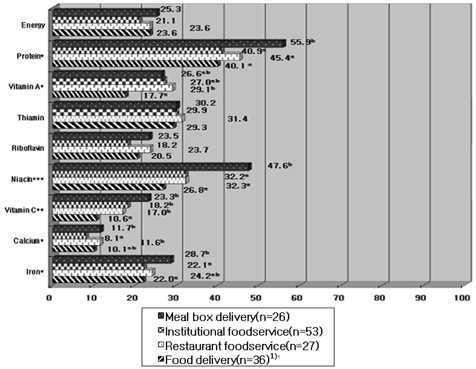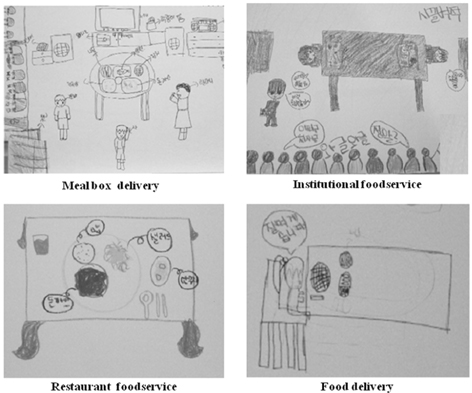Nutr Res Pract.
2010 Dec;4(6):515-521.
Diet of children under the government-funded meal support program in Korea
- Affiliations
-
- 1Department of Food and Nutrition, Seoul National University, 599 Gwanak-ro, Gwanak-gu, Seoul 151-742, Korea. hoonyoon@snu.ac.kr
- 2School of Hospitality Management, Pennsylvania State University, University Park, PA 16801, USA.
- 3Research Institute of Human Ecology, Seoul National University, 599 Gwanak-ro, Gwanak-gu, Seoul 151-742, Korea.
Abstract
- The purpose of this study was to investigate the diet of children under the government-funded meal support program. The 143 children (67 boys and 76 girls) participated in this study among 4th-6th elementary school students receiving free lunches during the summer vacation of 2007 and living in Gwanak-gu, Seoul, Korea. The subjects consisted of four groups supported by Meal Box Delivery (n = 26), Institutional Foodservice (n = 53), Restaurant Foodservice (n = 27), or Food Delivery (n = 37). A three-day 24-hour dietary recall and a self-administered survey were conducted. In addition, the children's heights and weights were measured. The average energy intake of the children was 1,400 kcal per day, much lower than the Estimated Energy Requirements of the pertinent age groups. The results also showed inadequate intake of all examined nutrients; of particular concern was the extremely low intake of calcium. On average, the children consumed eight dishes and 25 food items per day. The children supported by Meal Box Delivery consumed more various dishes and food items than the other groups. The percentage of children preferring their current meal support method was the highest in those supported by Meal Box Delivery and the lowest in those supported by Food Delivery. We requested 15 children among the 143 children participating in the survey to draw the scene of their lunch time. The drawings of the children supported by Institutional Foodservice showed more positive scenes than the other groups, especially in terms of human aspects. In conclusion, the overall diet of children under the government-funded meal support program was nutritionally inadequate, although the magnitude of the problems tended to differ by the meal support method. The results could be utilized as basic data for policy and programs regarding the government-funded meal support program for children from low-income families.
Keyword
Figure
Reference
-
1. Lee BJ. Status of children and adolescents in Korean. 2009. Ministry for Health, Welfare, and Family Affairs.2. Casey PH, Szeto K, Lensing S, Bogle M, Weber J. Children in food-insufficient, low-income families. Arch Pediatr Adolesc Med. 2001. 155:508–514.
Article3. Knol LL, Haughton B, Fitzhugh EC. Dietary patterns of young low-income US children. J Am Diet Assoc. 2005. 105:1765–1773.
Article4. Choi YS, Mo SM. Studies on nutrition of preschool children of low socio-economic group in Seoul-physical development and dietary intake. Journal of the Korean Public Health Association. 1977. 3:61–70.5. Noh MY. Estimation of food cost for low income families using food consumption data of the 2001 Korean National Health and Nutrition Survey [master's thesis]. 2006. Seoul National University.6. Bae EJ, Kwon JH, Yoon HJ, Lee SK. Nutritional status of school lunch supported students in an elementary school. Journal of the Korean Dietetic Association. 2001. 7:349–360.7. Shim JE, Yoon J, Lee K, Kwon S. Evaluation of dietary intake of Korean school-aged children from low-income families by comparing with the Korean food guide: Analysis of the data from the 2001 National Health and Nutrition Survey. The Korean Journal of Nutrition. 2009. 42:691–701.
Article8. The Ministry for Health and Welfare. 2010 Statistics about Child Foodservice Program. 2010. Unpublished raw data.9. Cotugna N, Vickery CE. Children rate the summer food service program. Family Economics and Nutrition Review. 2004. 16:3–11.10. Gordon A, Briefel R, Needels K, Wemmerus N, Zavitsky T, Russo R, Tasse T, Kalb L, Peterson A, Creel D. Feeding low-income children when school is out-The summer food service program. Economic research service. 2003.11. Nam KH, Kim YM, Lee GE, Lee YN, Joung HJ. Physical development and dietary behaviors of children in low-income families of Seoul area. Korean Journal of Community Nutrition. 2006. 11:172–179.12. The Ministry for Health and Welfare. 2006 Statistics about Child Foodservice Program. 2007. Unpublished raw data.13. The Korean Nutrition Society. CAN Pro 3.0 [Computer software]. 2005.14. The Korean Nutrition Society. Dietary reference intakes for Koreans. 2005. Seoul: Hanareum Publishing Co.;15–309.15. SAS Institute INC. SAS for Windows version 9.1 [Computer software]. 2001.16. The Ministry for Health and Welfare. The Korea Institute for Health and Social Affairs. The 2005 National Health and Nutrition Survey. 2006.17. Park NY, Choi YS. Nutritional status of school lunch-supported elementary school children in Gyeongbuk rural area. The Korean Journal of Nutrition. 2008. 41:341–352.18. Kim SH. Dietary copper intakes and nutritional status of copper in serum among elementary schoolchildren in Chungnam province in Korea: Comparison between remote rural and urban areas. The Korean Journal of Nutrition. 2006. 39:381–391.19. Langevin DD, Kwiatkowski C, McKay MG, Maillet JO, Touger-Decker R, Smith JK, Perlman A. Evaluation of diet quality and weight status of children from a low socioeconomic urban environment supports at risk classification. J Am Diet Assoc. 2007. 107:1973–1977.
Article20. Lyu LC, Yu YP, Lee JS, Lin JH, Wang HI. Food and nutrient intakes for families in Taipei, Taiwan. Journal of Food Composition and Analysis. 2006. 19:22–30.
Article21. Lee SS. The important function of calcium in relation to children's growth. Journal of the Korean Dietetic Association. 1999. 5:238–242.22. Youn HJ, Han YH, Hyun TS. Amounts and food sources of nutrients of elementary school lunch menus by the type of foodservice and the percent energy from fat. Korean Journal of Community Nutrition. 2007. 12:90–105.23. Egger RJ, Hofhuis EH, Sukonthanyakorn B, Van der Ven EM, Scriboonlue P, Wedel M, Saowakontha S, Schreurs WH. Food intake and socioeconomic status in children in northeast Thailand. Trop Geogr Med. 1991. 43:42–50.24. Shim JE. Analysis of dietary intake and development of balanced diet index among different age groups in Korea [Ph.D. thesis]. 2000. Seoul National University.25. Kim MS. National Human Rights Commission of Korea. Status on foodservice program for low-income children. 2007.26. Yoon B, Yoon J, Shim JE, Kwon S. Current status of meal box service management for children from low-income families during summer vacation. Korean Journal of Community Nutrition. 2009. 14:206–215.27. Bellack JP, Fleming JW. The use of projective techniques in pediatric nursing research from 1984 to 1993. J Pediatr Nurs. 1996. 11:10–28.
Article28. Pelander T, Lehtonen K, Leino-Kilpi H. Children in the hospital: elements of quality in drawings. J Pediatr Nurs. 2007. 22:333–341.
Article29. Adachi M. Theories of nutrition education and promotion in Japan: Enactment of the Food Education Basic Law. Asia Pac J Clin Nutr. 2008. 17:180–184.
- Full Text Links
- Actions
-
Cited
- CITED
-
- Close
- Share
- Similar articles
-
- Government-Funded Meal Support Program for Low-Income Children through Convenience Stores : Current Status and Nutritional Quality of Available Meal Items in Seoul
- The Current Status of Foodservice Management in the Restaurants Participating in the Government-funded Children's Model Program in Korea during Summer Vacation
- Influence on Health Promotion Behavior among Government-funded Research Institute's Employee according to Perceptive Health Status and Social Support
- Appropriate Size and Dish Combination of Nutritional-Balanced Lunch Boxes Delivered to Children Under the Government-Funded Meal Service Program in Korea
- Perception and Satisfaction of the Free School Meal Program for High School Students in Busan




